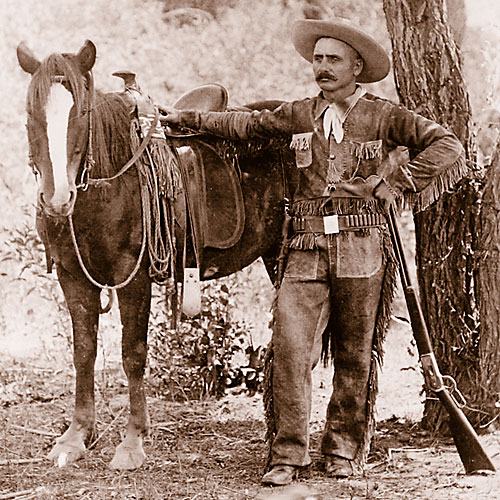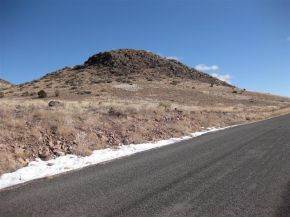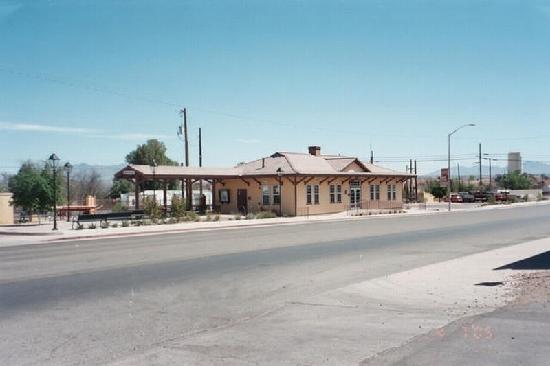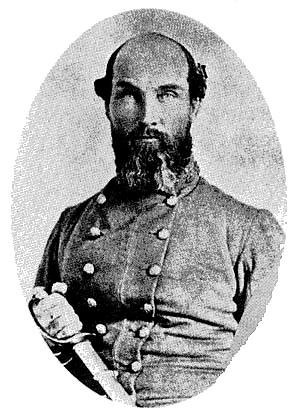
The battle at Apache Pass was a Conflict where only modern technology gave the Europeans/Americans a victory. As in many colonial battles it was not the men but their arms.

According to scout John C. Cremony and historian Dan L. Thrapp, the howitzer fire sent the Apaches into an immediate retreat. But Carleton's biographer, Aurora Hunt, wrote, "This was the first time that the Indians had faced artillery fire.
Nevertheless, they fought stubbornly for several hours before they fled." Geronimo later recalled in his autobiography that his people were winning the fight until "you fired your wagons at us." The Battle of Apache Pass was the only pitched battle the Apaches ever fought against the United States Army. Normally, the Apaches' tactics involved "guerrilla-style" warfare. Capt. Thomas Roberts was persuaded by the engagement that it would be best to find a route around Apache Pass, which he did. Gen. Carleton thus continued unhindered to New Mexico and subsequently took over as commander of the territory.At Apache Pass in 1862, Cochise and Mangas Coloradas, with around 500 fighters, held their ground against a New Mexico-bound force of California volunteers under General James Henry Carleton until caisson-mounted howitzer artillery fire was brought to bear on their positions in the rocks above.

In January 1863 Gen. Joseph Rodman West, under orders from Gen. Carleton, was able to capture Mangas Coloradas by duping him into a conference under a flag of truce. During what was to be a peaceful parley session, the Americans took the unsuspecting Mangas Coloradas prisoner and later murdered him.

This was just one more in a series of incidents that fanned the flames of enmity between the encroaching Americans and the Apache. For Cochise, the Americans held nothing sacred and had violated the rules of war by capturing and killing Mangas Coloradas during a parley .below pegasosession. Cochise and the Apaches continued their raids against American and Mexican settlements and military positions throughout the 1860s.
Cochise and the Apaches continued their raids against American and Mexican settlements and military positions throughout the 1860s.
 Cochise and the Apaches continued their raids against American and Mexican settlements and military positions throughout the 1860s.
Cochise and the Apaches continued their raids against American and Mexican settlements and military positions throughout the 1860s.
]above two texas ne'er do wells by replicants
al sieber
Scouting and tracking has a history in many lands and over many years. It was especially important in the westward expansion of the United States in the 1800s. It's an authentic chunk of American History of the old west. A few dozen white men came to master the wilderness and most of them began as trappers, mountain men and hunters. When the Army needed scouts it was an easy transition for these men. More than a thousand Indians, having been brought up to be hunters and warriors, proved to be valuable Army scouts between 1866 and the early 1900s.
Qualifying standards were high and to be chosen, wrote a scout "was a great honor." These brave men blazed the path for our country. Scouting and tracking work was demanding and dangerous: the scout was chief pathfinder, head forager for food and water, courier when necessary, provided reconnaissance, gathered intelligence, responsible for safety of his followers, diplomat in negotiations , caregiver and, when necessary, fight. K.Krause)
Al Sieber was born in 1844 in Mingolsheim, Germany (near Heidelberg) and came to Lancaster, Pennsylvania in 1849 and later to Minnesota in 1856. He served in the Civil War at the battles of Antietam, Fredericksburg and Gettysburg. He moved west in 1866 working as a miner and a railroad builder in California and Nevada.
 He arrived in Prescott around 1868 where he initially managed a ranch in what is now Williamson Valley.
He arrived in Prescott around 1868 where he initially managed a ranch in what is now Williamson Valley. 
By 1871 he was becoming a legend, primarily for his skill at what was called "Indian fighting." He had become an expert in Apache ways and was hired as Army Chief of Scouts by General George Crook that same year and worked out of Fort Whipple in Prescott as well as Camp Verde. General Crook's philosophy of Apache warfare was to trap Indians with Indians, and his eye fell on Sieber as a likely prospect to lead the way in getting the Indians back on the reservation when they strayed off of it. below Al sieber by replicants

Sieber dominated his Indian scouts by out-thinking, out-fighting, out-riding and out-shooting them, all the while treating them with respect and impeccable honesty. In 1872 and 1873, he was involved in most of Crook's so-called "Tonto Campaign" and, in 1875, helped transfer the Yapapais and the Tonto to the reservation at San Carlos. Sieber was partially responsible for keeping the death toll lower than it might have been on this treacherous journey. Though considered a rough man, he was admired and respected by Apaches and whites alike. His skills as a scout were unmatched and he conducted many missions for the Army until 1885 when he was replaced as Chief of Scouts by Tom Horn who had worked under Sieber and learned many of his skills from him. Interestingly, how did a German from Minnesota learn these skills in the first place?
After making peace, Cochise retired to his new reservation, with his friend Jeffords as agent, where he died of natural causes (probably abdominal cancer) in 1874. (below Commanchero by pegaso)He was buried in the rocks above one of his favorite camps in Arizona's Dragoon Mountains,he mountain range is one of Arizona's "sky islands". Mt. Glenn (7,520 ft/2,292 m) is highest point in the Dragoon Mountains. The Little Dragoon Mountains are the continuation of the Dragoon Mountains north of Texas Canyon.

Texas Canyon is located in Cochise County, Arizona about 20 miles east of Benson on Interstate 10 and lies between the Little Dragoon Mountains on the north and the Dragoon Mountains to the south. Known for the giant granite boulders, the canyon frequently attracts rockhounds and photographers.

 The warrior Cochise and his army defeated a small force of Confederate soldiers here at the First Battle of Dragoon Springs but was defeated at the Second Battle of Dragoon Springs a few days later.The First Battle of Dragoon Springs was a minor skirmish between a small troop of Confederate dragoons, of Governor John R. Baylor's Company A, Arizona
The warrior Cochise and his army defeated a small force of Confederate soldiers here at the First Battle of Dragoon Springs but was defeated at the Second Battle of Dragoon Springs a few days later.The First Battle of Dragoon Springs was a minor skirmish between a small troop of Confederate dragoons, of Governor John R. Baylor's Company A, Arizona four "Rebels" who are buried at Dragoon Springs died when they were ambushed by Apaches as they brought in a herd of cattle to Tucson from the east.Sylvester Mowry wrote the following obituary for John Donaldson:Killed by the Apache Indians, May 5, 1862, near Tucson, Arizona, Captain John Donaldson [who joined] Hunter's small Confederate force. Returning to Tucson from a short expedition, he fell in the rear of the troops to accompany a friend [Sam Ford] who had charge of a large herd of beeves. The Indians ambushed the party and Donaldson was killed at the first fire.***

In 1861 conventions held at Mesilla and Tucson advocated the separation of the parts of the New Mexico Territory territory below theGila River, which would be named "Arizona" and would be aligned with the Confederacy. This aim became a reality following the Confederate victory at the Battle of Mesilla on July 25, 1861.
On August 1, 1861, Lieutenant Colonel John R. Baylor, commanding the victorious Confederate troops at Mesilla, issued a proclamation declaring the creation of a provisional Confederate Territory of Arizona, to include all of the former United States Territory of New Mexico south of the 34th parallel north. He named himself as governor, and set up a functioning territorial government which would continue in operation until the Confederates were forced out of New Mexico in July 1862.below my conversion of a confederate officer this is now in production in metal, selling as unpainted. 

This Territory of Arizona was officially declared by Confederate President Jefferson Davis on February 14, 1862, and shortly thereafter Confederate forces were deployed on the ambitious New Mexico Campaign to gain control of the Southwest.
In order to make good the Confederacy's claim to the western portion of the New Mexico Territory, Confederate soldiers, commanded by Captain Sherod Hunter were ordered to occupy Tucson, arriving there on February 28, 1862.Dragoon Hotel 

They occupied the town until May 14, 1862, and it was a detachment of these troops which were involved in the fight at Dragoon Springs on May 5.On May 5, 1862, a small mounted Confederate foraging party was gathering stray cattle in the area around an abandoned Butterfield Overland Mail stagecoach station and spring in theDragoon Mountains, about sixteen miles from the present-day town of Benson and near Dragoon, Arizona. 

Train depot Benson Where Johnny Ringo killed Charlie Macleod.
A force of about 100 Chiricahua Apache warriors, commanded by the war chiefs Cochise and Francisco, ambushed the party. Four Confederate soldiers were killed, while the rest escaped from the ambush. The Apaches succeeded in capturing a large number of livestock and horses.
] This minor skirmish is noted for causing the Confederacy's westernmost battle deaths, and is the only known engagement in which Confederate soldiers were killed within the modern confines of Arizona. It can be seen as related to the Apache Wars fought between Apaches and the Americans . Below america Today
This minor skirmish is noted for causing the Confederacy's westernmost battle deaths, and is the only known engagement in which Confederate soldiers were killed within the modern confines of Arizona. It can be seen as related to the Apache Wars fought between Apaches and the Americans . Below america Today A few days later, on May 9, 1862, after hearing of the attack, Captain Sherod Hunter ordered his men to take back the captured herd of cattle and horses, as well as to get revenge for their fellow ambushed soldiers. The Confederates succeeded, recapturing the stolen animals and killing five Apaches for no loss of their own. The four dead soldiers were buried near the Dragoon Springs stage station, where they remain today near its well preserved remains.
A few days later, on May 9, 1862, after hearing of the attack, Captain Sherod Hunter ordered his men to take back the captured herd of cattle and horses, as well as to get revenge for their fellow ambushed soldiers. The Confederates succeeded, recapturing the stolen animals and killing five Apaches for no loss of their own. The four dead soldiers were buried near the Dragoon Springs stage station, where they remain today near its well preserved remains. hunter
hunter
This minor skirmish is noted for causing the Confederacy's westernmost battle deaths, and is the only known engagement in which Confederate soldiers were killed within the modern confines of Arizona. It can be seen as related to the Apache Wars fought between Apaches and the Americans . Below america Today

A few days later, on May 9, 1862, after hearing of the attack, Captain Sherod Hunter ordered his men to take back the captured herd of cattle and horses, as well as to get revenge for their fellow ambushed soldiers. The Confederates succeeded, recapturing the stolen animals and killing five Apaches for no loss of their own. The four dead soldiers were buried near the Dragoon Springs stage station, where they remain today near its well preserved remains. hunter
hunter
 hunter
hunterThe stagecoach route of the Butterfield Overland Mail passed through Texas Canyon from 1858 until the outbreak of the Civil War in 1862 when the stage line suspended operations. The canyon is historically within the range of the Chiricahua Apache, and Cochise made his last stronghold near here in the Dragoon Mountains during the mid-1870s.
from 1858 until the outbreak of the Civil War in 1862 when the stage line suspended operations. The canyon is historically within the range of the Chiricahua Apache, and Cochise made his last stronghold near here in the Dragoon Mountains during the mid-1870s.
 from 1858 until the outbreak of the Civil War in 1862 when the stage line suspended operations. The canyon is historically within the range of the Chiricahua Apache, and Cochise made his last stronghold near here in the Dragoon Mountains during the mid-1870s.
from 1858 until the outbreak of the Civil War in 1862 when the stage line suspended operations. The canyon is historically within the range of the Chiricahua Apache, and Cochise made his last stronghold near here in the Dragoon Mountains during the mid-1870s.
No comments:
Post a Comment